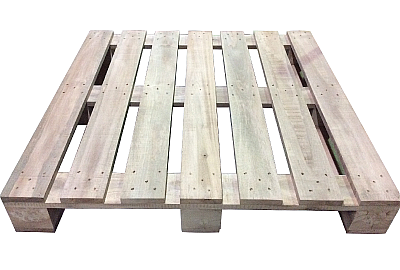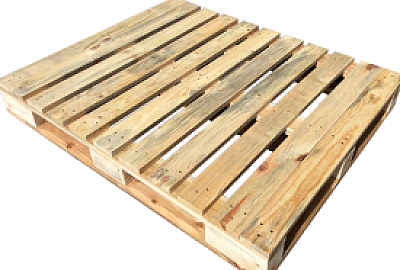Standardization and regulation pallet
Standardization and regulation pallet
Dimensions
Wooden pallets typically consist of three or four stringers that support several deckboards, on top of which goods are placed. In a pallet measurement the first number is the stringer length and the second is the deckboard length. Square or nearly square pallets help a load resist tipping.
Two-way pallets are designed to be lifted by the deckboards. The standard North American pallet, or GMA pallet, has stringers of 40 inches and deckboards of 48 inches.
Four-way pallets, or pallets for heavy loads (or general-purpose systems that might have heavy loads) are best lifted by their more rigid stringers. These pallets are usually heavier, bigger and more durable than two-way pallets.
Pallet users want pallets to easily pass through buildings, to stack and fit in racks, to be accessible to forklifts and pallet jacks and to function in automated warehouses. To avoid shipping air, pallets should also pack tightly inside intermodal containers and vans.
No universally accepted standards for pallet dimensions exist. Companies and organizations utilize hundreds of different pallet sizes around the globe. While no single dimensional standard governs pallet production, a few different sizes are widely used.
ISO pallets
The International Organization for Standardization (ISO) sanctions six pallet dimensions, detailed in ISO Standard 6780: Flat pallets for intercontinental materials handling—Principal dimensions and tolerances:
| Dimensions (W × L) millimetres |
Dimensions (W × L) inches |
Wasted floor, ISO container | Region most used in |
|---|---|---|---|
| 1016 × 1219 | 40.00 × 48.00 | 3.7% (20 pallets in 40 ft ISO) | North America |
| 1000 × 1200 | 39.37 × 47.24 | 6.7% | Europe, Asia; similar to 40" × 48". |
| 1165 × 1165 | 45.9 × 45.9 | 8.1% | Australia |
| 1067 × 1067 | 42.00 × 42.00 | 11.5% | North America, Europe, Asia |
| 1100 × 1100 | 43.30 × 43.30 | 14% | Asia |
| 800 × 1200 | 31.50 × 47.24 | 15.2% | Europe; fits many doorways |
North American pallets
Of the top pallets used in North America, the most commonly used by far is the Grocery Manufacturers' Association (GMA) pallet, which accounts for 30% of all new wood pallets produced in the United States. The ISO also recognizes the GMA pallet footprint as one of its six standard sizes.
| Dimensions, mm (W × L) | Dimensions, in (W × L) | Production Rank | Industries Using |
|---|---|---|---|
| 1016 × 1219 | 40 × 48 | 1 | Grocery, many others |
| 1067 ×1067 | 42 × 42 | 2 | Telecommunications, Paint |
| 1219 × 1219 | 48 × 48 | 3 | Drums |
| 1219 × 1016 | 48 × 40 | 4 | Military, Cement |
| 1219 × 1067 | 48 × 42 | 5 | Chemical, Beverage |
| 1016 × 1016 | 40 × 40 | 6 | Dairy |
| 1219 × 1143 | 48 × 45 | 7 | Automotive |
| 1118 × 1118 | 44 × 44 | 8 | Drums, Chemical |
| 914 × 914 | 36 × 36 | 9 | Beverage |
| 1219 × 914 | 48 × 36 | 10 | Beverage, Shingles, Packaged Paper |
| 889 × 1156 | 35 × 45.5 | Unknown | Military 1⁄2 ISO container, fits 36" standard doors |
| 1219 × 508 | 48 × 20 | Unknown | Retail |
European pallets
Main article: EUR-pallet
| EURO pallet type | Dimensions (W × L) | ISO pallet alternative | |
|---|---|---|---|
| EUR, EUR 1 | 800 mm × 1,200 mm | 31.50 in × 47.24 in | ISO1, same size as EUR |
| EUR 2 | 1,200 mm × 1,000 mm | 47.24 in × 39.37 in | ISO2 |
| EUR 3 | 1,000 mm × 1,200 mm | 39.37 in × 47.24 in | |
| EUR 6 | 800 mm × 600 mm | 31.50 in × 23.62 in | ISO0, half the size of EUR |
| 600 mm × 400 mm | 23.62 in × 15.75 in | quarter the size of EUR | |
| 400 mm × 300 mm | 15.75 in × 11.81 in | one-eighth the size of EUR | |
Australian standard pallets
Main article: Australia standard pallets
The Australian standard pallet is a pallet size commonly found in Australia but found rarely elsewhere. It is a square pallet originally made of hardwood 1,165 mm × 1,165 mm (45.87 in × 45.87 in) in size which fits perfectly in the RACE container of the Australian Railway. They are ill-suited for the standard 20 feet (6.1 m) and 40 feet (12 m) ISO shipping containers used around the globe. Australian standard pallets are usually manufactured in hardwood, but 1165 × 1165 mm pallets can also be manufactured using lighter timber suitable for use as disposable pallets using 16 millimetre boards. Extensively used in storage and warehousing, they are popular pallets for racking, with the right shape and size to be removed from transport and directly onto warehouse racking for storage.
The Australian Standard Pallet dates back to World War II, while ISO containers date to the late 1950s. Although the pallet's dimensions pre-date the ISO containers, it requires less dunnage, is square, and leaves less wasted space than other pallets, including the GMA pallet. In 2010, Australia adopted the globally accepted ISPM 15 wood packaging material regulations (before this time it was hardwood and more expensive).
Standard-setting organizations
A number of different organizations and associations around the world work towards establishing and promulgating standards for pallets. Some strive to develop universal standards for pallet dimensions, types of material used in construction, performance standards, and testing procedures. Other organizations choose to focus on pallet standards for a specific industry (such as groceries) or type of material (such as wood).
ISO Technical Committee 51: Pallets for unit load method of materials handling
ISO TC 51 states its scope of work entailing the "standardization of pallets in general use in the form of platforms or trays on which goods may be packed to form unit loads for handling by mechanical devices". The Technical Committee works in conjunction with other Technical Committees focused on transportation infrastructure to develop interrelated standards. TC 51 is responsible for developing ISO Standard 6780: Flat pallets for intercontinental materials handling—Principal dimensions and tolerances as well as sixteen other standards related to pallet construction and testing.
National Wood Pallet and Container Association
The National Wood Pallet and Container Association (NWPCA) is a trade organization based in the United States representing the interests of wood pallet and container manufacturers.
U.S. DOD, Dept. of Navy, Naval Sea Systems Command
This organization maintains MIL-STD-1660, the standard description of palletized unit loads for the U.S. Military and some allies.
DOD Unit loads generally use 40 in × 48 in (1,016 mm × 1,219 mm) pallets, are less than 4,000 lb (1,814 kg), weatherproof, and stack 16 ft (4.88 m) high. They often use steel pallets, steel straps with notched seals, outdoor plywood, and plastic film. The standard describes tests for stacking, transport, sling, forklift and pallet jack, impact, drop tests, tip, water-retention, and disassembly.
European Committee for Standardization (Comité Européen de Normalisation)
In addition to the other standards it publishes, the European Committee for Standardization, also known as the Comité Européen de Normalisation (CEN), produces standards for pallets. While the standards are voluntary in nature, many companies and organizations involved in transportation have adopted them. The major standard for pallets produced by CEN is ICS: 55.180.20 General purpose pallets
Phytosanitary compliance

Due to the International Plant Protection Convention (abbreviated IPPC), most pallets shipped across national borders must be made of materials that are incapable of being a carrier of invasive species of insects and plant diseases. The standards for these pallets are specified in ISPM 15.
Pallets made of raw, untreated wood are not compliant with ISPM 15. To be compliant the pallets (or other wood packaging material) must meet debarked standards, and must be treated by either of the following means under the supervision of an approved agency:
Heat treatment The wood must be heated to achieve a minimum core temperature of 56 °C (132.8 °F) for at least 30 minutes. Pallets treated via this method bear the initials HT near the IPPC logo.
Chemical fumigation The wood must be fumigated with methyl bromide. Pallets treated via this method bear the initials MB near the IPPC logo. From 19 March 2010 the use of Methyl Bromide as an acceptable treatment according to ISPM15 has now been banned within all EU member states. This is due to causing potential harm to the Earth's stratospheric ozone layer.
Treated wood pallets must be stamped on two opposite sides indicating either HT for heat treated or MB for methyl bromide treatment.
Pallets made of non-wood materials such as steel, aluminum, plastic, or engineered wood products, such as plywood, oriented strand board, or corrugated fiberboard do not need IPPC approval, and are considered to be exempt from ISPM 15 regulations.


